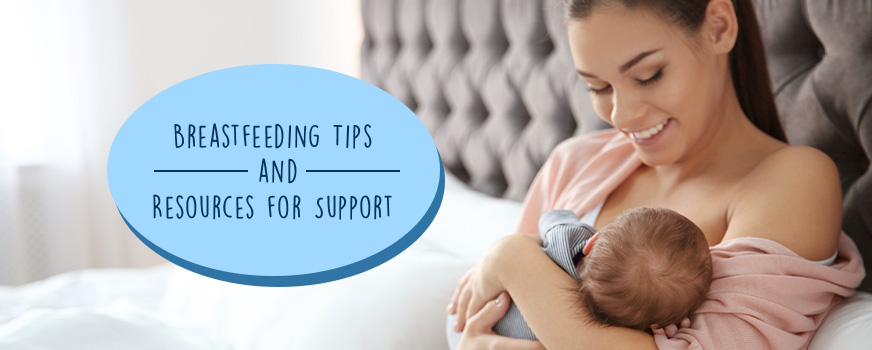
Breastfeeding doesn’t always come easily, and it can become a stressful task if you feel like you “aren’t getting it right away.” But do not worry! If you have chosen to breastfeed, every situation is different, so finding the right solution for yourself will be a bit of trial and error. Learn more about breastfeeding and find tips on how to make the experience the best for you and your baby.
Be Prepared & Educated
Whether you are reading this before giving birth and are preparing for postpartum or are currently looking for breastfeeding tips after your baby has arrived, being prepared and educated is key. Of course, there is no exact way to prepare for your exact situation, but taking the steps to know about the basics of breastfeeding can help you better navigate your own breastfeeding experience once the time comes.
Talk to Your Doctor
Make sure your doctor knows you plan to breastfeed. They can give you some resources. Ask questions about what type of care the hospital provides after birth. Some offer lactation consultants who are breastfeeding specialists.
Take Breastfeeding Classes
Though breastfeeding classes won’t be an exact replica of your own experience, having experience even in a practice setting can help you practice technique for the real thing. Be sure to ask questions in class if any arise.
Stock Up on Breastfeeding Items
Plan ahead by purchasing the breastfeeding items you need before you need them. These can include a nursing pillow, nursing bra, and covers. Some hospitals and insurance plans provide free breast pumps.

Find the Right Position
You can hold your baby in a number of ways, and what’s most important is what position feels most comfortable for you and your baby while breastfeeding. Some of the most common positions are:
- Cradle – Put your baby’s head in the crook of your arm. Support your baby’s back and bottom with your forearm. Your baby should be lying facing you. Your breast should be right in front of your baby’s face.
- Side-lying – While lying down, place your baby alongside you. Your baby should be facing you. Pull your baby close to you so he or she can latch on. You can use a pillow to prop up, if needed. This position can help if you had a cesarean section (C-section). You don’t want to fall asleep while nursing in this (or any other) position. Co-sleeping can be dangerous for your baby. It increases the risk of Sudden Infant Death Syndrome (SIDS).
- Football – Tuck your baby under your arm, along your side. His or her head should be resting in your hand. Support your baby’s body with your forearm. Your baby should be facing you. This position can help if you had a C-section. It also can help if your breasts are large, your baby is small, or you have multiple babies.
- Cross-cradle – Hold your baby with the opposite arm of the breast you’re using. Support your baby’s head and bottom with the palm of your hand and forearm. Your baby should still be lying facing you. This position can help premature babies or babies who have a weak suck. It provides added head support.

Make Sure Baby is Latched
Finding a good latch will help both you and your baby when breastfeeding. When your baby is “latched on” the right way, both lips should pout out and cover nearly all of your areola. Your baby’s jaw should begin to move back and forth. Your baby may make low-pitched swallowing noises instead of smacking noises. If you feel pain while your baby is nursing, they may not be latched on.
Your baby’s nose may touch your breast during nursing. Babies’ noses are designed to allow air to get in and out. If you’re concerned your baby can’t breathe easily, gently press down on your breast near your baby’s nose to give them more room to breathe. Your baby shouldn’t have to turn their head or strain their neck to nurse.
Feed Baby When Needed
Feed your baby as often as they want to be fed and learn how to tell when your baby is hungry. Crying can be a sign of hunger, but it’s not the best indicator as babies who are crying or are upset have a harder time latching on. Watch out for early signs of hunger before crying starts. Your baby may make sucking motions, turn toward the breast if they are being held, put their hands in their mouth, or become excited or alert to show they are ready to eat.
After birth, your baby may be hungry 8 to 12 times a day or more. This number may decrease over time or increase during a growth spurt. Growth spurts occur at about 2 weeks and 6 weeks of age and again at about 3 months and 6 months of age. Let your baby eat until they are satisfied. This may be for about 15 to 20 minutes at each breast.
Try to have your baby nurse from both breasts at each feeding. Your baby is getting enough milk if they act satisfied after each feeding, gain weight consistently after the first 3 to 7 days after birth, have about 6 to 8 wet diapers a day, or have about 2-5 or more stools a day at first – which may decrease to about 2 stools or less a day.
Sometimes babies fall asleep while nursing. You can squeeze your breast to make more milk flow. This may awaken your baby. If you are not sure they got enough milk, offer your other breast to see if your baby latches on again. Make sure your baby finishes one breast before starting the other. Your baby should let go on their own once they are done.
Don’t limit the time you let your baby nurse. It may keep your milk ducts from completely emptying. This can decrease your milk flow and make it harder for your baby to latch it on. It also can cause swelling and pain. Applying a cold compress before nursing can ease discomfort.

Eat a Healthy Diet
Having a healthy diet yourself will help ensure your baby is also having a healthy diet while breastfeeding. The best diet is well balanced and has plenty of calcium. A balanced diet includes eating from all 5 food groups. You should get 5 servings of milk or dairy products each day. It is okay to eat foods that were restricted while you were pregnant. These will not make your baby sick.
You should eat about 500 extra calories per day. Make sure you drink extra fluids as well. Continue to take a prenatal vitamin so your body gets enough nutrients, and talk to your doctor about supplements if you eat a restricted diet.
Ask for Help
The most important breastfeeding tip for new moms is to read ahead, educate yourself, and be willing to ask for help. Decrease your anxiety about breastfeeding by reading about it, taking classes, and learning as much as you can before the baby comes and even after birth. The more you try and have patience with yourself and your baby! The more you ask for help, the easier it can become. For further support, consider joining a postpartum support group to connect with other parents going through similar challenges.
Other breastfeeding support can be found here:
- Kellymom.com – an evidence-based website about breastfeeding that’s very useful before and during breastfeeding.
- LLLUSA.org – The La Leche League website includes links to local support groups.
- Various breastfeeding apps – Time can blend together, especially in the first few days after you give birth. An app can help you keep track of when you fed your baby last, for how long, and on which side. This can help reduce your stress so you don’t need to keep track of so many details.
Breastfeeding can be a long and rewarding journey and can take some time to get used to. Some people can pick it up right away while others may take weeks of finding the solution that works best for them. Having support and education can play huge parts in your breastfeeding experience. Even then, breastfeeding is a personal choice and may or may not be the best feeding option for you and your baby.
If breastfeeding works for you, incredible! If formula or bottles work better, also incredible! There are amazing opportunities to bond with your baby, no matter which approach you take. The most important thing to keep in mind is making sure you and your baby are comfortable and getting the appropriate nutrients for a healthy future.



